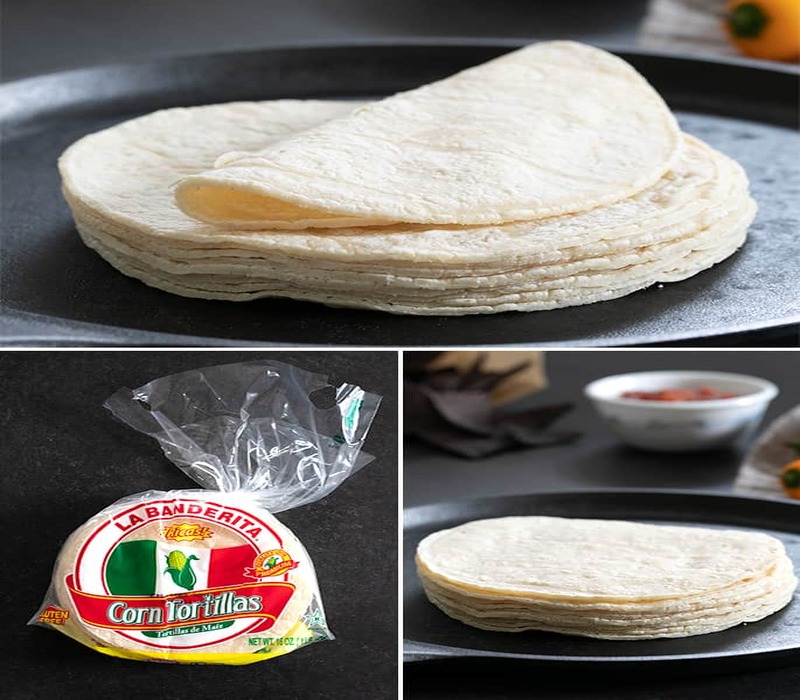Tortilla, also known as Tlaxcalli. A Tortilla is a flat, circular, unfermented bread made from maize that has been baked in lime (CaO) or wheat flour (Triticum aestivum L.) and corn (Zea mays L.). In some regions of Central America, Maize is usually combined with sorghum (Sorghum bicolour L.) to make Tortillas. Wheat flour and maize Tortillas are processed and produced in quite different ways.

Page Contents
Origin And History of Tortilla
A Tortilla is a sort of thin flatbread that is pressed and cooked using unleavened, water-based dough and finely ground wheat flour. The word Tortilla, which translates to “little cake” in Spanish, refers to a kind of maize Tortilla. The earliest discovered Tortillas were fashioned of local maize with dried kernels and date back to 10,000 BC. It served as the main source of nutrition for the Mesoamerican Aztecs. South Asia has a similar flatbread known as “chapati.” Countries with their own wheat flatbread that resemble Tortillas may be found in western Arabia, the eastern Mediterranean, and southern Asia.
Traditionally, Tortillas were produced from nixtamalized maize flour and were consumed across the Mexican area. Wheat flour is now frequently used to make it. Their textures vary. Wheat is softer and may be made broader and thinner without breaking as easily as maize, which is thicker and more brittle. Maize tortillas are consumed as tortilla chips or as a component in Enchiladas, Tostadas, or flautas in western regions of the world. Burritos are a cuisine from northern Mexico that is made with a Tortilla made of wheat flour.
Benefits of Tortillas
Tortilla contains essential Nutrients like fibres, Vitamins, mineral
Dietary Fibre
Dietary fibre, a kind of Carbohydrate crucial to digestion, is included in Tortillas. Fibre helps you stay regular by giving your stool more weight, which helps avoid constipation. Additionally, it softens your poop to make it simpler to pass. According to the Harvard School of Public Health, dietary fibre also aids in the prevention of diseases like diabetes and heart disease. According to Harvard, men need 38 grammes of fibre per day, compared to 25 grammes for women. You may increase your fibre intake by 2.7 grammes by eating a 12-inchTtortilla. To increase your intake of fibre, use whole-grain Tortillas rather than white Tortillas.
Iron
By increasing your intake of iron, Tortillas are good for your circulation. According to the NYU Langone Medical Center, a 12-inch Tortilla has 3.9 milligrams of iron, which is 22% or 49% of the daily needs for women and men, respectively. You can make Haemoglobin, a protein required for the blood to carry oxygen, thanks to iron. Additionally, it stimulates brain cell communication, aids in the production of immune system-supporting enzymes, and aids in the absorption of vitamin A.
Niacin
Niacin, or vitamin B-3, which you need to help your metabolism, is also present in tortillas. It helps your body break down proteins, carbs, and fats so that your cells can utilise them as fuel. The levels of Niacin must be enough. It also affects cell communication, your body’s reaction to stress, and cell formation and proliferation. In a 12-inch Tortilla, there are 4.3 milligrams of Niacin.
Varieties of Tortillas (Tlaxcalli)
There are two varieties of Tortillas,
- Corn Tortillas
- Flour Tortillas
The primary component in corn Tortillas is corn, whereas the primary ingredient in flour Tortillas is wheat flour. This is the basic distinction between corn and flour Tortillas. Since corn has been a common component in Mexican cuisine for millennia, corn Tortillas are thought to be more representative of traditional Mexican cuisine. While this is true for corn, wheat has only been domesticated since the Spanish introduced it to the Americas. Compared to flour Tortillas, which are significantly whiter in colour and are much larger, corn Tortillas are yellow and tend to be smaller. To make flour Tortillas, you only need flour, a little salt, and water.
As compared to flour Tortillas, corn tortillas have more fibre and are manufactured from whole grains, which means they have fewer calories, salt, and carbohydrates. They are also devoid of gluten. Regarding preparing and eating, several individuals gripe that maize tortillas are prone to breaking.
Guerrero Flour Tortillas
Prepare Guerrero 100% Whole Wheat Soft Taco Flour Tortillas with components that are high in nutrients and stuffed with grains and nutritional fibre. Whole wheat Tortillas from Guerrero are a nutritious supplement to your handmade Mexican meals. Guerrero flour Tortillas have a delicate texture and a traditional flavour that complement any recipe, whether it is a classic Mexican meal or a dish with a contemporary touch. In Guerrero, Tortilla calories are approx 130. Guerrero White Corn Tortillas don’t have any lard, trans fat, or cholesterol and are also gluten-free.
Are Guerrero Tortillas Healthy?
Guerrero Corn Tortillas are low in fat, gluten-free, and have a rich amount of fibre, so you can be sure that you are feeding your family well-balanced meals.

Nutritional Value
Many people frequently use Tortillas, especially those made with wheat flour in place of pan bread. Due to the increased shortening content (5-15% based on flour weight) in their composition, flour Tortillas have higher gross and digestible energy levels. White flour Tortillas have less ash, protein, and fibre than whole-meal Tortillas.
The major source of energy, protein, calcium and other vital elements in the diets of Central Americans and Mexico is maize Tortillas. Cooking with lime dramatically boosts calcium and Niacin’s bioavailability while also reducing the number of aflatoxins and fumonisins in infected maize.
Because of the oil absorbed during frying and the low post-processing moisture levels of table Tortillas, maize chips and Tortilla chips have much greater calorie densities than those foods. The B-vitamins, Fe, and Zn content of Tortillas and snacks made from enhanced dried masa flour is higher than that of snacks made from fresh masa. Also, government regulations mandate that dried masa flours in Mexico be fortified; certain of these flours may be enhanced with 5% soy flour.
Guerrero Tortilla Calories
There are 130 Calories in Guerrero White Corn Tortillas.
| Calories | 130 |
| Calories from fat | 45 |
| Total Fat | 5g |
| Cholesterol | 0mg |
| Sodium | 260mg |
| Total Carbohydrate | 17g |
| Dietary Fibre | 1g |
| Sugars | 1g |
| Protein | 3g |
| Calcium | 4% |
| Iron | 8% |
Ingredients for Preparing Guerrero Flour Tortillas
- Enriched Bleached Flour (Flour, Niacin, Reduced Iron, Thiamine Mononitrate, Riboflavin, Folic Acid)
- Water
- Vegetable Shortening (Interesterified and Hydrogenated Soybean Oils)
- Contains 2% or Less of Salt
- Baking Soda
- Sodium Acid Pyrophosphate
- Fumaric Acid
- Calcium Propionate and Sorbic Acid (to Maintain Freshness)
Steps for Preparation of Tortilla (Tlaxcalli)
Ready to Cook Guerrero Fresqui-Ricas With Fajita Flour Tortillas, you can enjoy the flavour of real, handcrafted Tortillas without doing all the labour. In about 90 seconds, you can prepare Tortillas by heating them in a hot pan. Our kosher Tortillas are made using premium ingredients and time-honoured methods; they never include lard.
- Firstly Heat the skillet to medium heat.
- Cook each side of the Tortilla for approx 30 seconds.
- Flip a third time and cook for approx 30 sec until puffed.
- Finally serve warm and enjoy.
Packaging of Tlaxcalli
You can cool the heated Tortillas through a succession of open levels that are frequently equipped with fans that exhaust into the packing area for 3 to 5 minutes. The efficiency of chilling significantly affects the shelf life of Tortillas. Tortillas that are improperly cooled before stacking and packing cling together and condense moisture inside the container. Furthermore, automated machinery is used in contemporary companies to count, stack, and package Tortillas in plastic bags. Tortillas are often counted mechanically using switch sensors, Integrated Circuits, or Photoelectric Detectors.
Conclusion
Around the world, Tortillas are getting more and more well-liked. Because they are hard and break when folded, stale Tortillas are no longer acceptable to customers. Ingredients, manufacturing conditions, and flour constituents, particularly starch and protein, are all related to Tortilla staling. Proteins, or enzymes, are organic and Biodegradable substances that can replace chemical ingredients in baked products. They have the capacity to alter and affect many Tortilla components, extending shelf life, enhancing mixing tolerance and proofing stability, improving crumb whiteness and structure, producing a more intense crust colour, and allowing the substitution of chemical additives.
In the refrigerator, corn and flour tortillas only last for approximately a month. Tortillas can remain fresh in the freezer for up to 6–8 months if they are properly preserved.
For around 12 hours, these tortillas can be kept at room temperature. After that, keep them in the refrigerator in an airtight container.
Yes, flour tortillas can go bad. They can become brittle and hard, making them unpleasant to consume. In general, tortillas go bad whether they are opened or not. However, if you store your tortillas properly, you may increase their shelf life and preserve their freshness.


